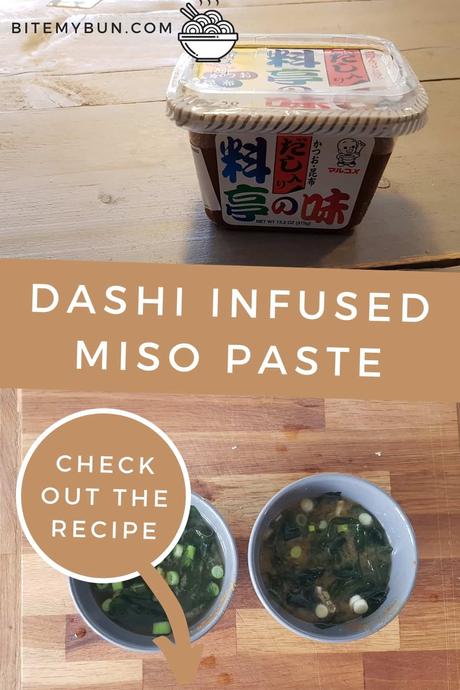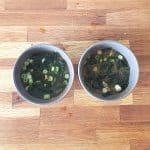If you’ve ever eaten Japanese food, then you’re probably familiar with miso soup. Miso is a popular Japanese seasoning that many people just can’t get enough of. It does take some getting used to though.
But miso can be used for so much more than just soup. It gives food a variety of flavorful elements!
In miso’s raw form, it has a sticky, gooey substance, called miso paste. It can be used to flavor different dishes, including soups, sauces, and marinades.

There are several ways to make miso and one way is to make it with dashi, a flavorful broth that’s popular in Japanese cuisine. Perfect for a fast miso soup!
This article will take a look at miso and dashi and what happens when you mix the 2 together. I’ll also take a look at some popular miso products made with dashi.
Delicious dashi-infused miso recipe
* If you like Asian food, I’ve made some great videos with recipes & ingredient explanations on YouTube you’d probably enjoy:
Subscribe on YouTube
 Print
Print
Miso soup with dashi-infused miso
If you're wondering how to make miso soup with dashi, here’s a recipe you'll want to try! Course SoupCuisine JapaneseKeyword miso soup Prep Time 2 minutesCook Time 1 minuteTotal Time 3 minutes Servings 2 people Author Joost Nusselder Cost $1Ingredients
- 4 cups water
- 3 tbsp dashi-infused miso paste
- 1 handful wakame diced
- 1 medium 4 1/8” long green onions sliced diagonally into ½” pieces
Instructions
- Gather all of your ingredients.
- Separate the layers of green onions. cut them. and add them to the bowl.
- Rehydrate the wakame in a separate bowl for 5 minutes.
- Squeeze out the water from the wakame and add it to your bowl.
- Add in the dashi-infused miso paste.
- Boil water (in a kettle is the easiest) and pour it over the ingredients, then stir.
- Let it sit for 2 to 3 minutes before serving.
Notes
Miso soup is traditionally served with a side of rice, making for a hearty meal.Best miso products with dashi in them
If you’re interested in miso products with dashi in them, here are a few that I recommend.
Hikari organic dashi miso paste bonito and kelp stock
This organic miso dashi paste contains 5 types of dashi:

It has a deep miso flavor that comes from a long fermentation process. This organic miso paste has all-natural ingredients and is great for making soup!
Japanese miso dashi soup paste
Customers say this miso soup paste is delicious. It’s great for using in soups and it’s essentially miso with dashi infused in it as well:

(view more images)
What is miso?
When most people hear the word “miso”, they automatically think of the soup of the same name.
However, miso is actually the flavoring used to make the soup so delicious!
The seasoning is made by combining fermenting soybeans with salt and koji (the fungus Aspergillus oryzae). Rice, barley, seaweed, and other ingredients are thrown in.
Miso is known for being high in protein and rich in vitamins.
It has a salty flavor and a rich aroma that can vary according to the ingredients and fermentation process. Its taste has been described as salty, sweet, earthy, fruity, and savory.
What is dashi?
Dashi is a simple broth that’s prepared by heating water containing kombu (edible kelp) and kezurikatsuo (shavings of katsuobushi, preserved fermented skipjack, or bonito) to near-boiling.
The resulting liquid is then strained. The katsuobushi and kombu help give it a savory umami flavor that characterizes many Japanese dishes.
The kicker is that dashi is actually used as the base of many Japanese soups, including clear broth, noodle broth soups and, you got it: miso.
So if you like a nice cup of miso soup, you really can’t do without dashi.
How to store miso soup
Once miso soup is prepared, you can store it in the refrigerator in a tightly sealed container. This will prevent any bacteria from growing.
For the best results, eat within 3 days.
Different types of miso
There are several different types of miso. They differ in taste due to the ingredients and time they’re left to ferment.
Here are some of the most popular types:
- White miso: White miso is made from soybeans and a lot of rice. It’s fermented to produce a light sweet taste that’s great for soups, dressings, and marinades.
- Red miso: Red miso is made from soybeans, barley, and various grains. It has a rich umami flavor that’s great for marinating meats and flavoring hearty soups and stews.
- Awase: Awase is a mix of red and white miso. It can be used in all types of Japanese cuisine.
There are several other types of miso that come from various regions of Japan and these can be seasoned any way you choose. However, the most popular additions are barley or dashi.
Barley miso is made from soybeans and grains to create a flavor that’s great for flavoring soups and vegetables.
Miso that’s mixed with dashi comes in the form of a soup that’s absolutely delicious with green onions and tofu added.
Other uses for miso
Miso doesn’t necessarily have to be used in soup. In fact, it doesn’t have to be cooked at all!
If you’re looking for ways to incorporate healthy and delicious miso into your recipes, here are some ideas:
- Miso dressing: Miso dressing can be made in a variety of ways. One idea is to crush it with cucumbers and green beans. This is perfect for putting on salads or it can also work as a dressing for other foods.
- Glazes and marinades: Miso can also work well as a glaze or marinade for a variety of meats. You’ll need to dilute it with water, butter, vinegar, or some sort of sauce. Once you combine the ingredients, it’ll work to flavor chicken, pork, and other types of meat.
- Stir-fries: Miso is also terrific when added into stir-fries. It gives the dish a great umami flavor!
Other uses for dashi
While dashi is commonly associated with miso soup, it can be used in a variety of applications.
In addition to being used as the base for other kinds of soup, it also makes a flavorful poaching liquid. For example, it can be used to poach eggs.
Fish and vegetables can also be simmered in dashi to add a flavorful element. It also makes a great brine for fish and chicken.
Plus, dashi can be added to vinaigrettes, which can be used on salads or added to dips.
Because dashi is rich in vitamins and minerals, it also makes a soothing elixir. When warmed, it can be used to aid digestion and soothe sore throats.
Add miso with dashi to your diet
Now that you know more about miso and dashi, you can make delicious foods and take entrees to the next level.
How will you be using these tasty Japanese ingredients in your meals?
